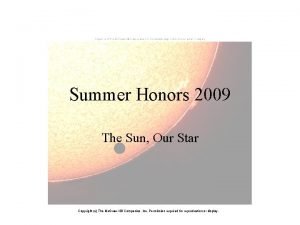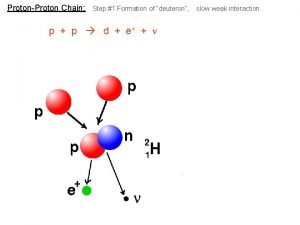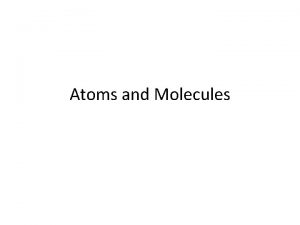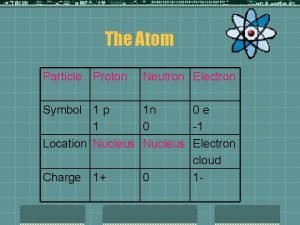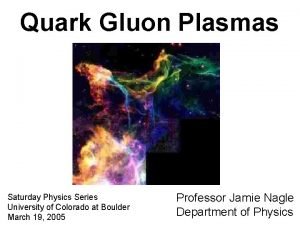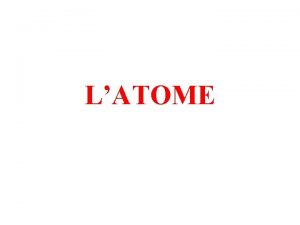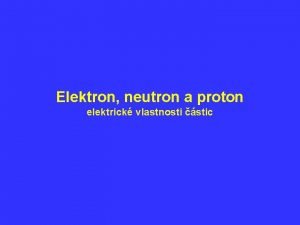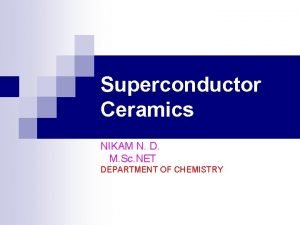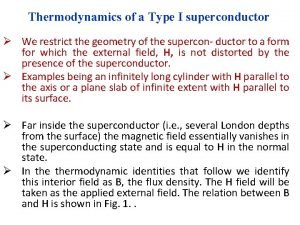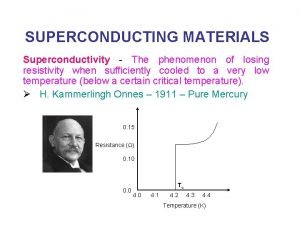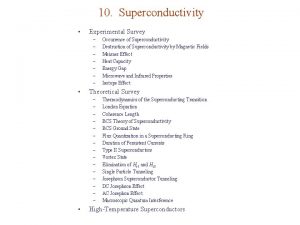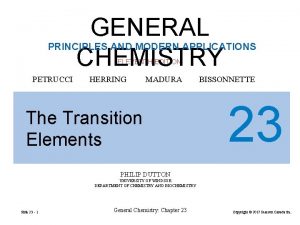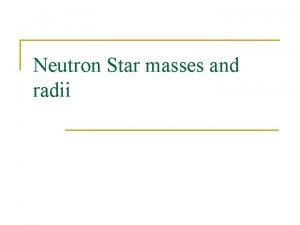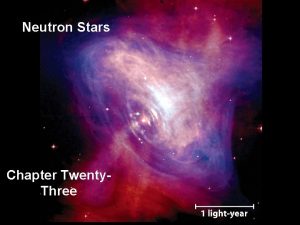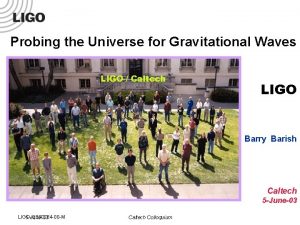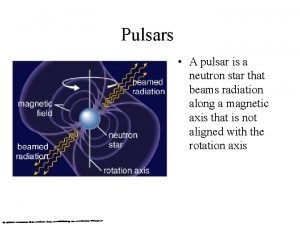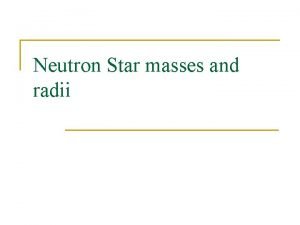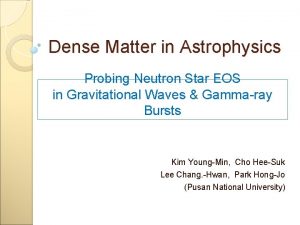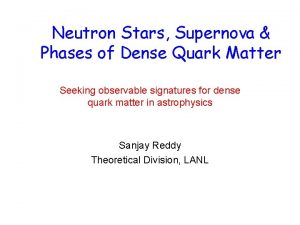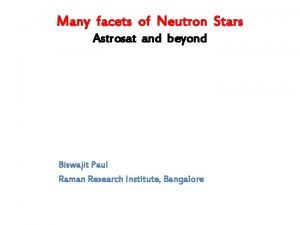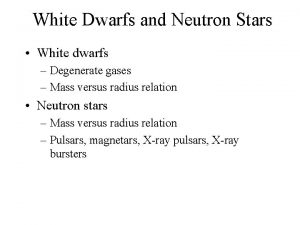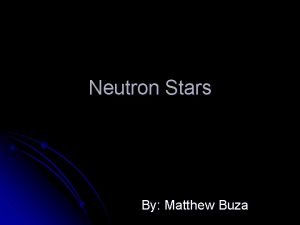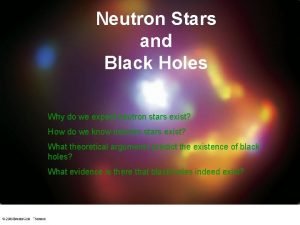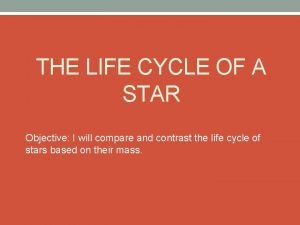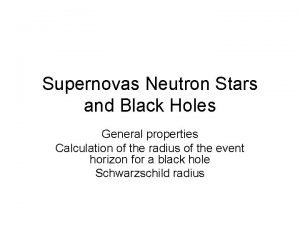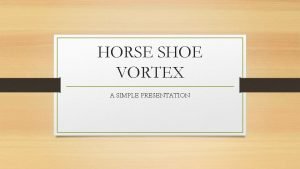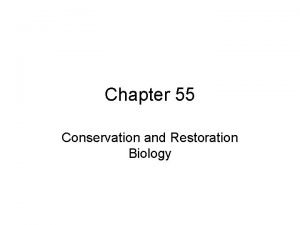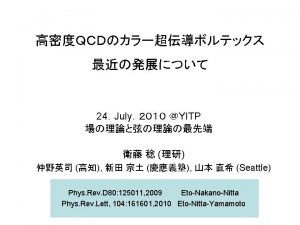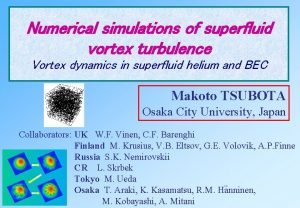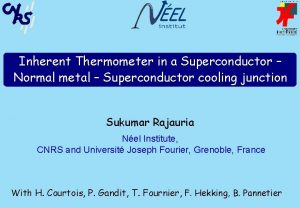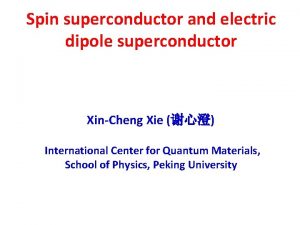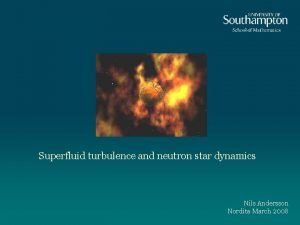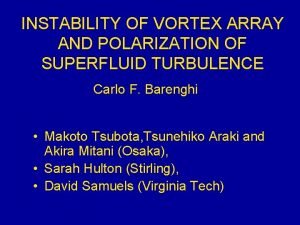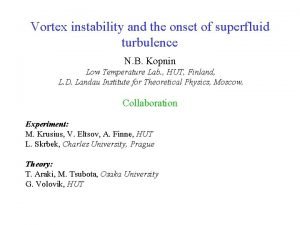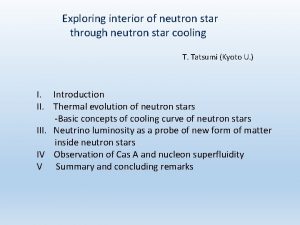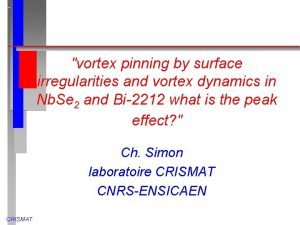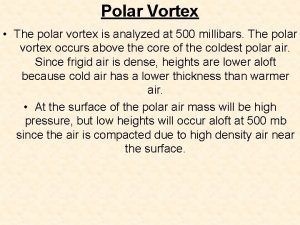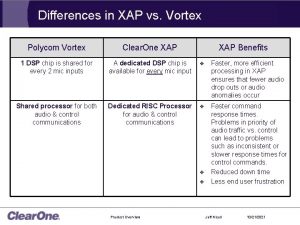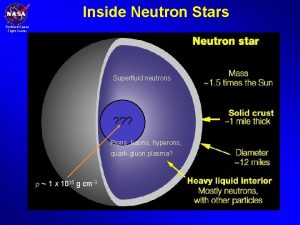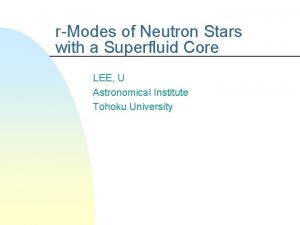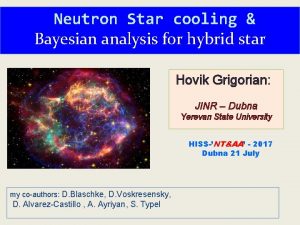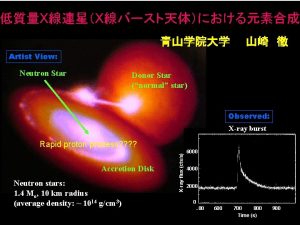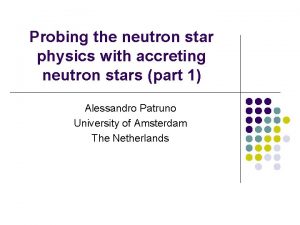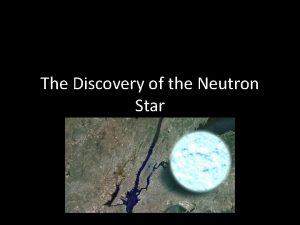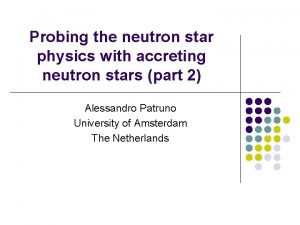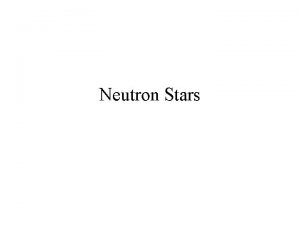Neutron star Neutron superfluid Proton superconductor Neutron vortex


































- Slides: 34



Neutron star Neutron superfluid Proton superconductor Neutron vortex Proton vortex カラー超伝導 (CFL相) カラー超伝導 ボルテックス


話の流れ 1. 導入部 2. vortex 3. Color-superconductor 4. Non-Abelian vortex と NGモード 5. s-quark の質量 6. まとめと展望 レビュー 結果

2.vortex


Ginzburg-Landau theory • 超流動 • 超伝導



Vortex in dense QCD 高密度QCDのボルテックスは 超流動 カラー超伝導 両方の性質を持つ。 Semi-superfluid vortex と呼ばれている Balachandran-Digal-Matsuura (PRD 73, 074009)

3.Color-superconductor


Dense QCD (u, d, s) Alford-Rajagopal-Wilczek(‘ 98), Bailin-Love (‘ 84) 1. Weak coupling Asymptotic free: 2. Quark Cooper paring 3. color-superconductor(CSC) & color-flavor lock (CFL) SU(3)c is broken and color and flavor is locked.

Primary condensate: color/flavor/spin anti-symmetric Alford-Rajagopal-Wilczek(’ 98)


4. Non-Abelian vortex と NGモード

Ginzburg-Landau Lagrangian Iida-Baym (PRD 63, 074018) Weak coupling QCD result

基底状態(order parameter space)



Superfluid vortex(triple) Forbes-Zhitnitsky (PRD 65, 085009), Iida-Baym (PRD 66, 014015) Semi-superfluid vortex (minimal) Balachandran-Digal-Matsuura (PRD 73, 074009)

Full numerical solution Gap increasing (m 1>m 8) Eto-Nitta (PRD 80, 125007)


Nambu-Goldstone mode vortex Nakano-Nitta-Matsuura (PRD 78, 054002)

Eto-Nakano-Nitta (PRD 80, 125011) moduli parameter moduli field Manton method Abelian vortex Non-Abelian vortex

Dynamics of non-Abelian NG mode Eto-Nakano-Nitta (PRD 80, 125011) CP(2) Lagrangian

Determination of Kahler class Shifman-Yung Ansatz (PRD 71, 045010) Kahler class (Lagrangian for ρ) Numerically solve EOM with vortex background FINITE! ⇒ normalizable mode

Strange quark mass and vortex stability So far we have considered asymptotically high density However, in a more realistic situation like neutron star, we should take an effect of strange masss into account. Iida-Matsuura-Tachibana-Hatsuda (PRL 93, 132001)

Strange quark mass is small but non-zero SU(3)C+L+R is approximate symmetry. CP 2 NG zero mode becomes slightly massive An effective potential in CP 2 vortex theory Eto-Nitta-Yamamoto (PRL) Massless CP 2 NLSM ⇒ massive CP 2 NLSM

low high


Future directions • Glitch phenomena of neutron star • Vortex-particle scattering => cooling mechanism • Connection of superfluid vortex in hadronic matter and non-Abelian vortex in quark matter • Quark-Hadron continuity (duality) • Monople and confinment

Quark-Hadron continuity (duality) Phase Interaction NG Vector Fermion (Skyrmion) Condensate mechanism confinement Low density Confinement Strong 8 Meson 9 Baryon 8 Baryon Monopole Dual Missner Quark High density Higgs Weak 8+1 Gluon 8 Quark 9 Quark Diquark Missner D E Monopole NT A
 Superfluid example
Superfluid example Proton proton chain
Proton proton chain Fission definition
Fission definition Proton proton chain
Proton proton chain Star of wonder star of night star of royal beauty bright
Star of wonder star of night star of royal beauty bright Atom proton neutron electron
Atom proton neutron electron Symbole proton neutron electron
Symbole proton neutron electron Proton neutron quarks
Proton neutron quarks How to find neutrons on periodic table
How to find neutrons on periodic table Proton neutron
Proton neutron Proton neutron elektron
Proton neutron elektron Proton neutron quarks
Proton neutron quarks Superconductor ceramics
Superconductor ceramics Superconductor examples
Superconductor examples Isotope effect in superconductors ppt
Isotope effect in superconductors ppt Persistent currents
Persistent currents Superconductor
Superconductor Neutron star
Neutron star Neutron star
Neutron star Binary neutron star
Binary neutron star Neutron star
Neutron star Neutron star
Neutron star Neutron star
Neutron star Neutron star
Neutron star Neutron star router
Neutron star router Neutron star
Neutron star Crab nebula neutron star
Crab nebula neutron star Neutron star
Neutron star How neutron stars form
How neutron stars form White dwarf neutron star black hole
White dwarf neutron star black hole Schwarzschild radius
Schwarzschild radius Karman vortex maf sensor
Karman vortex maf sensor Horse shoe vortex
Horse shoe vortex Extinction vortex
Extinction vortex échauffement athlétisme cycle 3
échauffement athlétisme cycle 3

